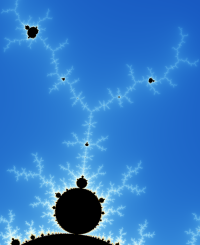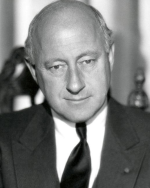Tag Archives: Mandelbrot fractal
 In recent posts I’ve presented the complex numbers and the complex plane. Those were just stepping stones to this post, which involves a basic fact about the Mandelbrot set. It’s something that I stumbled over recently (after tiptoeing around it many times, because math).
In recent posts I’ve presented the complex numbers and the complex plane. Those were just stepping stones to this post, which involves a basic fact about the Mandelbrot set. It’s something that I stumbled over recently (after tiptoeing around it many times, because math).
This is one of those places where something that seems complicated turns out to have a fairly simple (and kinda cool) way to see it when approached the right way. In this case, it’s the way multiplication rotates points on the complex plane. This allows us to actually visualize certain equations.
With that, we’re ready to move on to the “heart” of the matter…
Continue reading
20 Comments | tags: cartioid, complex numbers, fun with numbers, Mandelbrot, Mandelbrot fractal, real numbers | posted in Math

Math version 1.0
This image here of the Mandelbrot fractal might look like one of the uglier renderings you’ve seen, but it’s a thing of beauty to me. That’s because some code I wrote created it. Which, in itself, isn’t a deal (let alone a big one), but how that code works kind of is (at least for me).
The short version: the code implements special virtual math for calculating the Mandelbrot. That the image looks anything at all like it should shows the code works.
Yet according to that image, something wasn’t quite right.
Continue reading
8 Comments | tags: algorithm, Mandelbrot, Mandelbrot fractal, virtual reality | posted in Computers

Complete Chaos!
One of my favorite discoveries in life is the Mandelbrot set. Considering it gives me a strong sense of the numinous. I’ve been enthralled by it ever since Fractint, an MS-DOS program that generated fractals. I’ve posted about it a lot here; today I want to take you into the heart of its chaotic behavior.
The Mandelbrot set has a number of properties that make it such a fascinating study: Firstly, it demonstrates chaos theory. Secondly, it demonstrates how complex patterns can arise from simple beginnings. Thirdly, it reveals a problem concerning real numbers. Fourthly, every pixel is a demonstration of Turing’s Halting Problem. It’s also infinitely complex and incredibly beautiful.
Today we’re going to explore the shore of the Mandelbrot lake.
Continue reading
6 Comments | tags: chaos, chaos theory, fractals, Mandelbrot, Mandelbrot fractal | posted in Science
 The Thanksgiving holiday we celebrate here in the USA has some unfortunate overtones regarding its colonial origin. Still, the idea of a festival of thanks is an ancient one — thanks for a good harvest or a good hunt. Or, in our case, thanks for helping us not die last winter.
The Thanksgiving holiday we celebrate here in the USA has some unfortunate overtones regarding its colonial origin. Still, the idea of a festival of thanks is an ancient one — thanks for a good harvest or a good hunt. Or, in our case, thanks for helping us not die last winter.
As with Christmas or the Copenhagen interpretation, we tend to take a “shut up and calculate!” approach to the holidays. “Shut up and shop!” in the case of the Winter Solstice, and “Shut up and give thanks!” today.
One thing we can be very thankful about is patterns…
Continue reading
3 Comments | tags: atoms, DNA, electrons, entropy, Mandelbrot, Mandelbrot fractal, photons, quarks, Thanksgiving | posted in Life
I had thoughts about a second May Mandelbrot post that got a bit deeper into the weeds, but a couple attempts today went nowhere (except the trashcan). But I been having some fun exploring the Mandelbrot with Ultra Fractal, and I thought some pictures might be worth a few words.

Click on any to see bigger versions.
Continue reading
3 Comments | tags: Mandelbrot, Mandelbrot fractal | posted in Computers

Mandelbrot Antennae
[click for big]
I’ve heard it called “the most complex” mathematical object, but that’s a hard title to earn, let alone hold. Its complexity does have attractive and fascinating aspects, though. For most, its visceral visual beauty puts it miles ahead of the cool intellectual poetry of Euler’s Identity (both beauties live on the same block, though).
For me, the cool thing about the Mandelbrot is that it’s a computation that can never be fully computed.
Continue reading
11 Comments | tags: computation, computer model, computer program, fractals, Mandelbrot, Mandelbrot fractal, mathematics, Turing Halting Problem | posted in Computers, Math

Zzzzzzzzzzz-t!
One of those annoying-to-those-who-know-better shortcuts that movies and TV shows sometimes take is the visual trope of throwing a piece of wood (or a rock) at an “electrified fence” and producing an exciting shower of sparks. Typically, one character is just about to touch the fence, only to be pulled back just in time by another character who throws something at the fence to show the first character how they almost bought it.
It looks good — everyone loves a good sparking. In fact, you may have noticed how many action scenes take place in factories that seem mainly to manufacture sparks and steam. You may have noticed how often welders seem to be creating showers of sparks in the background of every action movie.
But this isn’t about our love of sparks.
Continue reading
10 Comments | tags: amperage, amps, conductor, delta, delta-v, differences, differential, diversity, electric fence, electrical current, electrical pressure, electricity, insulator, Mandelbrot fractal, non-conductor, sparks, voltage, volts, water pipes, water pressure, water tower | posted in Basics

Tick-Tock, goes the clock…
Last time, in the Determined Thoughts post, I talked about physical determinism, which is the idea that the universe is a machine — like a clock — that is ticking off the minutes of existence. The famous French mathematician, Pierre-Simon Laplace (the “French Newton”), was the first (in 1814) to articulate the idea of causal determinism.
We now know that quantum mechanics makes it impossible to know both the position and motion of particles, so Laplace’s Demon isn’t possible at the sub-atomic level. (It might be possible at the classical or macro level — that’s an open question.) Sometimes the issue of chaos theory is proposed as a counter-argument to determinism, so I thought I’d cover what chaos theory is and how it might apply.
If you want to skip to the punchline, the answer is it doesn’t apply at all.
Continue reading
7 Comments | tags: butterfly effect, chaos theory, Edward Lorenz, KAOS, Lorenz attractor, Mandelbrot, Mandelbrot fractal, Pierre-Simon Laplace, strange attractor, weather, weather prediction | posted in Math
 In recent posts I’ve presented the complex numbers and the complex plane. Those were just stepping stones to this post, which involves a basic fact about the Mandelbrot set. It’s something that I stumbled over recently (after tiptoeing around it many times, because math).
In recent posts I’ve presented the complex numbers and the complex plane. Those were just stepping stones to this post, which involves a basic fact about the Mandelbrot set. It’s something that I stumbled over recently (after tiptoeing around it many times, because math).


















